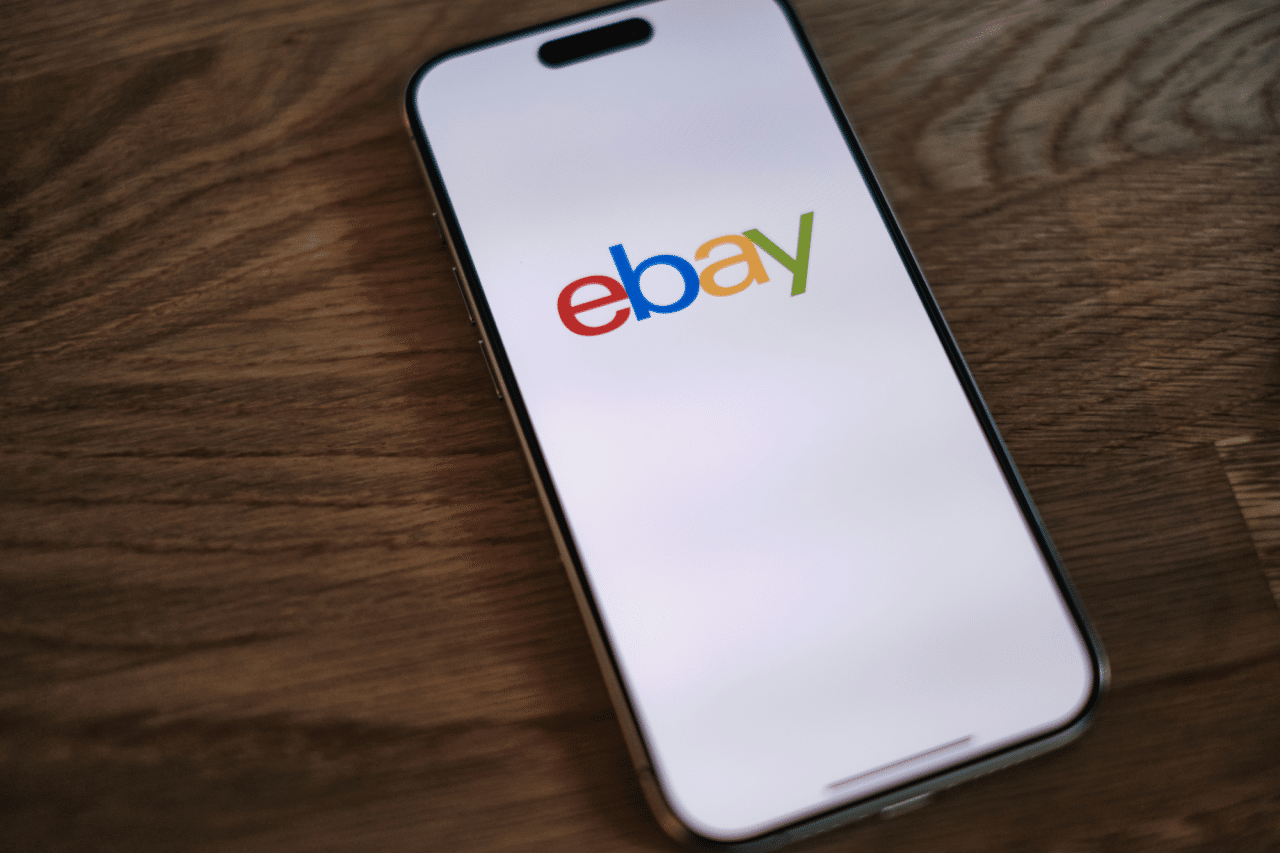How to Identify Winning Products for E-commerce Success
Contents

We’ve all been there—excited to sell a new product, only to watch it barely get any attention. It’s frustrating, right? You might wonder why some products take off while others flop.
A winning product isn’t just about luck; it’s about hitting the right mix of what people want and what makes them buy.
In this guide, I’ll show you what makes products successful. You’ll learn how to spot must-haves and understand what people are looking for.
Key Takeaways
- Winning products have key characteristics: they solve problems, spark emotional connections, or offer something unique and hard to find.
- Tools like Sell The Trend’s Nexus Tool make it easy to identify trending products with proven demand and growth potential.
- High profit margins and scalability are critical for maintaining a successful e-commerce business.
- Products with high demand but low competition give you an edge in the market.
- Focusing on what people truly want or need increases your chances of success.
How to Spot a Winning Product: 4 Key Characteristics to Look For
I’ve learned one thing: not every product is a winner. A winning product delivers real value to your customers and keeps your business profitable. Some products stand out because they meet specific needs or spark excitement, while others fade into the background.
Through trial and error, I’ve identified 5 key qualities that consistently define a winning product. These are:
- It solves real problems or meets desires.
- It’s unique, eye-catching, and hard to find.
- It offers great profit margins and scalability.
- It’s in high demand but has low competition.
Let’s go through them one by one.
1. It Solves Real Problems or Meets Desires
A winning product solves a problem or fulfills a desire. If it doesn’t make life easier, more enjoyable, or more convenient, it’s unlikely to succeed. People don’t just buy things—they buy solutions or experiences that add value to their lives.
How do you identify a product that solves a problem or meets a desire?
Start by asking yourself: What does this product do for someone? For example, noise-canceling headphones exploded in popularity during the work-from-home era. Why? They solved a problem—distracting noise—and fulfilled a desire for focus and productivity. Similarly, reusable water bottles gained traction because they addressed environmental concerns while offering convenience.
But not every solution is obvious. A good product doesn’t have to cure world hunger—it can be as simple as saving time or making someone smile.
If you’re unsure, dig deeper:
- Browse Amazon reviews and look for recurring complaints or wish lists for similar products.
- Search Reddit threads like r/LifeHacks to see what people are struggling with or what they wish existed.
- Ask potential customers directly through polls or surveys.
Using Instagram polls is an easy way to gather direct feedback. For instance, the poll in the image asks, “How do you prefer your coffee?” Simple questions like this can reveal trends or preferences. If a majority answers “Latte,” you might explore related products like latte-making kits, flavored syrups, or reusable coffee mugs.
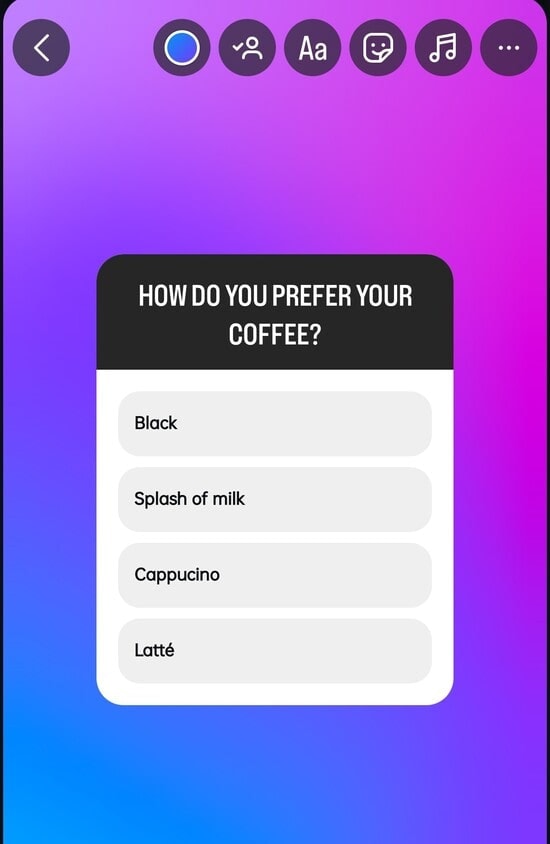
What if the product isn’t solving a problem yet?
New products can also succeed if they tap into desires that customers didn’t know they had. For example, I once marketed a decorative yet functional phone holder. People weren’t actively searching for it, but once they saw it, they loved the mix of style and utility.
The key is this: Make the benefit clear. Whether it saves time, reduces frustration, or adds joy, customers need to instantly see the value.
If the product doesn’t address a need or desire, it’s unlikely to move the needle.
2. It’s Unique, Eye-Catching, and Hard to Find
Winning products don’t just blend in—they stand out. If a product feels special, looks appealing, or is hard to find elsewhere, people are more likely to buy it. The uniqueness adds a sense of exclusivity, making customers feel like they’re getting something truly valuable.
What does it mean for a product to be unique?
It can mean different things:
- A sleek design or innovative features, like collapsible water bottles save space.
- A product that’s not widely available, such as handmade items or limited-edition collections.
- Something visually striking that grabs attention, like neon-accented gadgets or quirky home decor.
How do you find unique products?
Look where others aren’t looking:
- Etsy: Handmade and customizable items often stand out.
- AliExpress New Arrivals: These products are fresh to the market, giving you a head start before competitors catch on.
- Social media: Check Instagram or TikTok trends using hashtags like #UniqueFinds or #TrendingNow to spot viral, eye-catching items.
What if the product isn’t entirely unique?
Even if a product already exists, you can make it feel special by improving it. Think about offering:
- Better packaging or presentation.
- Exclusive color variations or bundling.
- A targeted marketing angle that resonates with a specific group.
For example, I once launched a basic fitness tracker but rebranded it for moms looking to stay active. By tweaking the messaging and packaging, it appealed to a niche audience and felt unique to them.
Remember, uniqueness is about more than the product itself—it’s about how it makes the customer feel. If buyers believe they’re getting something rare or special, they’re more likely to hit “Add to Cart.”
3. It Offers Great Profit Margins and Scalability
A winning product doesn’t just sell well—it makes money. If a product costs too much to produce, ship, or market, it will drain your resources, no matter how popular it is. High profit margins and scalability are key to long-term success in e-commerce.
What are profit margins, and why do they matter?
Profit margins are the difference between what you sell a product for and what it costs you to make, market, and deliver. For example, if you sell a product for $50 but your total cost (including production, shipping, and marketing) is $30, your profit margin is $20—or 40%.
From my experience, a minimum of 50% margin is ideal to cover expenses like ads and unexpected fees while leaving room for profit.
How do you ensure scalability?
Scalability means being able to grow without overwhelming costs. A product that sells well at small volumes but becomes expensive to manage as demand grows isn’t scalable. Here’s what to check:
- Supplier reliability: Can they handle larger orders without delays or quality issues?
- Production efficiency: Are there cost-saving measures you can introduce at higher volumes?
- Shipping logistics: Bulk shipping options can significantly reduce costs as you scale.
Tools like Alibaba or Faire are great for sourcing scalable products. These platforms connect you with suppliers who can adjust to your growth.
How do you calculate profitability?
I recommend using tools like Shopify’s Profit Margin Calculator to break down costs and estimate your earnings. When sourcing a product, I always ask these three questions:
- What’s the total cost (including production, shipping, and fees)?
- How much can I reasonably sell it for?
- Can I increase my profit by bundling or upselling related products?
4. It’s in High Demand but Has Low Competition
The best products are the ones people want but not everyone is selling. Striking the perfect balance between demand and competition is like finding gold in e-commerce. High demand means there’s a market, while low competition gives you room to stand out and capture sales.
How do you validate if a winning product is in high demand?
Demand is all about what customers are actively searching for and buying. I’ve used tools like Google Trends to track search interest over time. For example, when I saw searches for “portable camping stoves” spike before summer, I knew it was a product with seasonal demand. Similarly, SEMrush and Ahrefs can show search volumes for specific keywords, helping you gauge whether people are looking for the product.
See how I checked if the global pet care market is in trend. I searched for pet supplies niches on Google Trends and here is a screenshot of what I got:
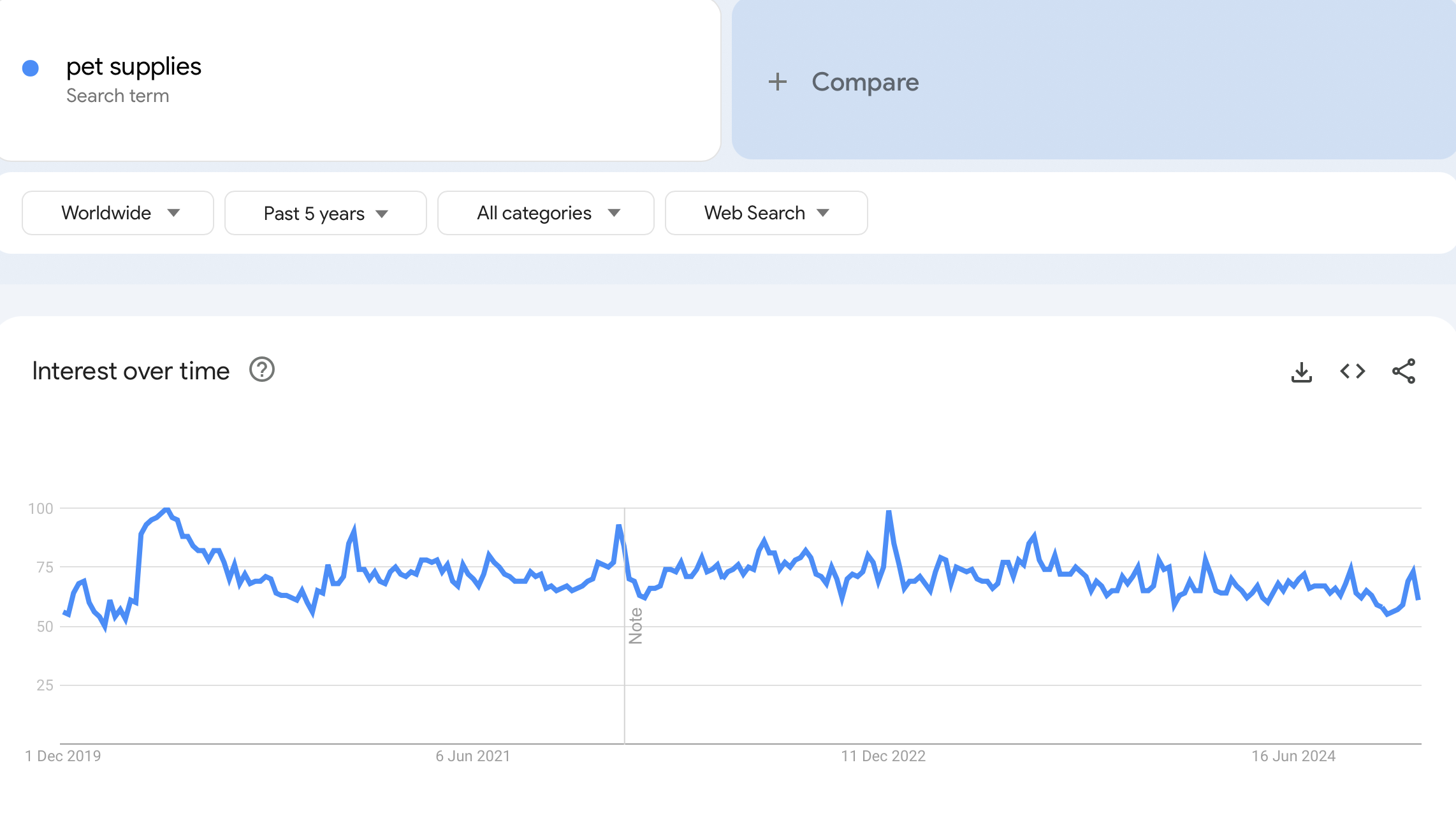
The chart shows consistent interest over the past five years, with regular peaks that likely align with seasonal or promotional periods. This steady demand tells us that products in the pet supplies market are worth exploring.
Another trick is to check Amazon Best Sellers in your niche. Products with consistent sales and great reviews often point to high demand. However, be cautious—what’s popular today might fade tomorrow. Look for items with steady or growing interest.
How do you find low-competition products?
Low competition means fewer sellers, which makes it easier for you to stand out. Here’s what I do:
- Search on Amazon and eBay: If a product has only a handful of sellers or minimal reviews, it’s a good sign of low competition.
- Explore niche platforms: Websites like Etsy or Bonanza often feature trending products that haven’t yet saturated larger markets.
- Use dropshipping directories: Tools like Sell The Trend can help you identify trending products that aren’t widely available yet.
What if demand is high, but competition exists?
High demand often attracts competitors, but you can still carve out your space. I’ve done this by offering:
- Better quality: If competing products have complaints about durability or function, fix those issues.
- Niche targeting: Market the product to a specific group, like fitness enthusiasts or busy parents.
- Unique branding: Eye-catching packaging or storytelling can make your product feel different.
What Mistakes Should You Avoid When Choosing Products?
Not all products are created equal, and choosing the wrong one can cost you time, money, and even customers. Over the years, I’ve made some mistakes, but I’ve also learned how to avoid them. Here are the most common pitfalls to watch out for when selecting products—and how to steer clear of them.
1. Don’t Jump Into Overcrowded Niches
One of the biggest mistakes I made early on was entering a market that was oversaturated. I thought I could compete by offering the same product as everyone else, only to realize I was just another seller in a sea of options.
How do you avoid this?
- Research your competition on platforms like Amazon and eBay. If dozens of sellers offer the same item at a similar price, it’s time to reconsider.
- Look for unique angles or underserved niches. For example, instead of selling generic yoga mats, target a specific audience, like eco-conscious buyers, with mats made from sustainable materials.
2. Avoid Ignoring Product Quality for Short-Term Gains
When I first started, I focused too much on cutting costs and ended up selling products that didn’t meet customer expectations. The result? Poor reviews, returns, and lost trust.
Why does this happen?
Cheap products may seem appealing because of their high margins, but they often lead to customer dissatisfaction. A single bad experience can make customers avoid your store altogether.
How do you avoid this?
- Order samples before committing to a supplier. Check the product’s durability, packaging, and overall quality.
- Prioritize products that solve problems without compromising on materials or functionality.
To boost your chances of success on e-commerce platforms, using the right tools is essential. Modern product discovery tools for e-commerces help sellers analyze demand, track competitors, and validate product ideas before investing. These tools save time, reduce guesswork, and provide actionable insights that give you a competitive edge in crowded markets.
3 Tools To Help You Find Winning Products
1. Sell The Trend
Sell The Trend is my go-to tool for finding winning products. It combines product research, trend tracking, and supplier connections all in one place. I use it to discover trending products before they go viral.
Main Features:
- Nexus Product Research Tool: Shows trending products across AliExpress, Shopify, and Amazon.
- Store Explorer: Lets you analyze top-performing Shopify stores.
- Video Ad Maker: Helps you create quick product videos for ads.
- AliExpress Integration: Allows you to source and import products easily.
How to Find Winning Products on Sell The Trend:
- Open the Nexus Tool and search for products in your niche. Focus on items with growing order trends.
- Check the Trending Products section for items with high sales and strong reviews.
- Use the Store Explorer to see what’s selling in successful Shopify stores. Take inspiration from their top products.
For example, here is a trending product that I found on Sell The Trend—a wireless car air compressor. This product fits perfectly into the growing global car accessories market. It has over 39,000 orders, $631,000 in total sales, and a steady rise in the order trends chart. The data clearly shows that people love this product because it solves a real problem: keeping tires inflated on the go.
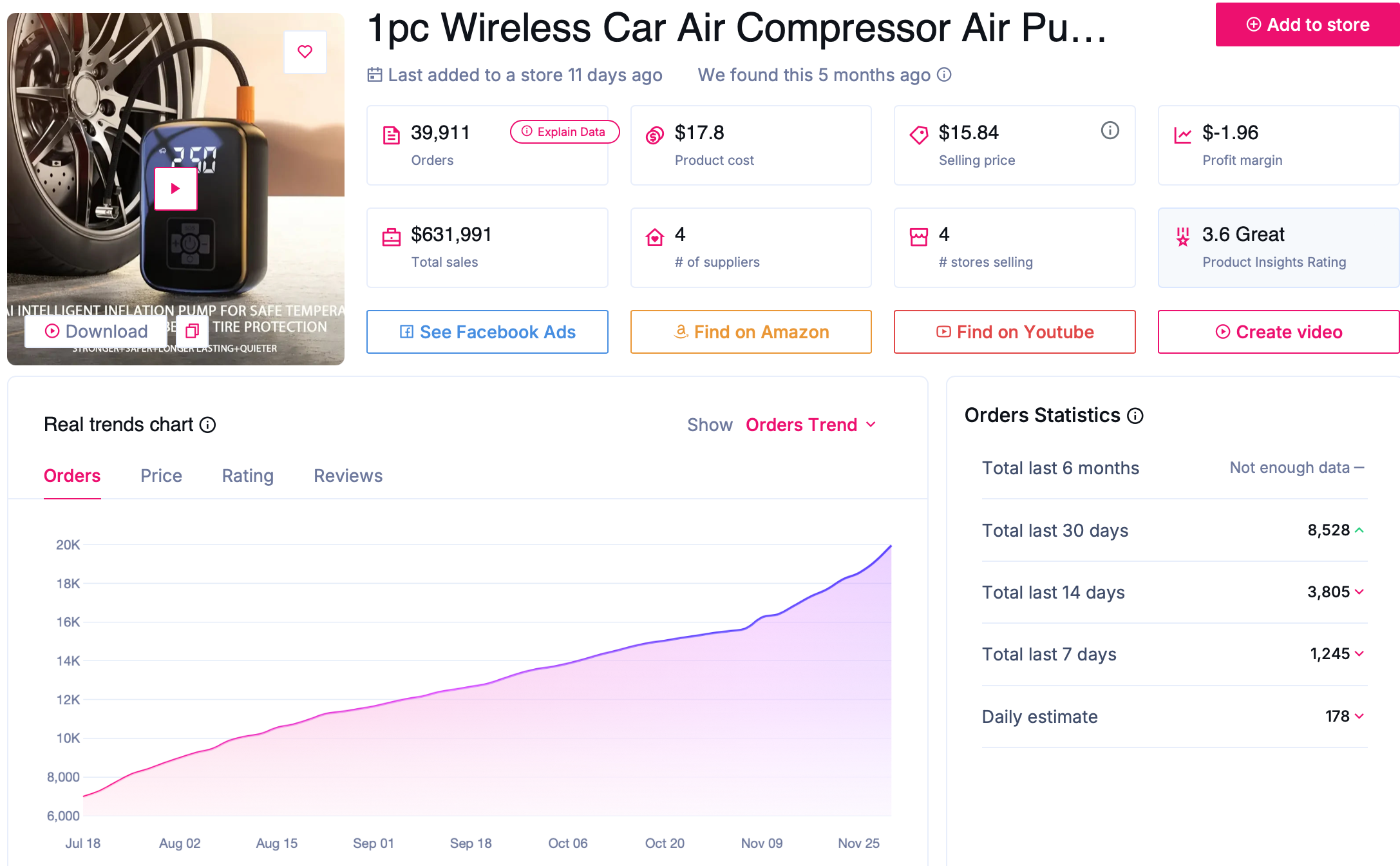
Pros:
- Easy to use, even for beginners.
- Combines product research and trend tracking in one dashboard.
- Saves time by showing you products with proven sales data.
Cons:
- The subscription cost might be high for beginners.
- It focuses mainly on e-commerce platforms, so it’s less helpful for non-e-commerce sellers.
Sell The Trend is a powerful tool that simplifies finding products people want to buy. If you’re serious about e-commerce, it’s worth the investment
2. Instagram
Instagram is where I discover viral and influencer-promoted products. It’s a platform full of inspiration for products that grab attention and appeal to niche audiences.
Main Features:
- Explore Page: Shows trending posts and products based on your activity.
- Hashtags: Use tags like #TikTokMadeMeBuyIt or #TrendingNow to find popular items.
- Influencers: Follow accounts in your niche to see what products they promote.
How to Find Winning Products on Instagram:
- Search hashtags related to your niche or trending phrases.
- Follow influencers who share product reviews and recommendations. Look for posts with high engagement.
- Pay attention to reels or stories showcasing products and how they’re used.
For example, I came across Giallo Zafferano’s Instagram account while searching for food-related inspiration. They focus on Italian cuisine and have a massive following of over 4.3 million.
By exploring their posts, I noticed trending kitchen gadgets and ingredients featured in their recipes. These items are perfect for targeting the food and cooking enthusiast market.

Using Instagram, you can find products tied to specific lifestyles or passions. In this case, I could target kitchen accessories, like pasta makers or specialty food items, that align with the audience’s interests.
Pros:
- Great for spotting viral products in real-time.
- Offers insights into how products are used and marketed.
- Direct access to influencer promotions.
Cons:
- Trends can fade quickly, so timing is crucial.
- Doesn’t provide detailed sales or competition data.
3. Pinterest
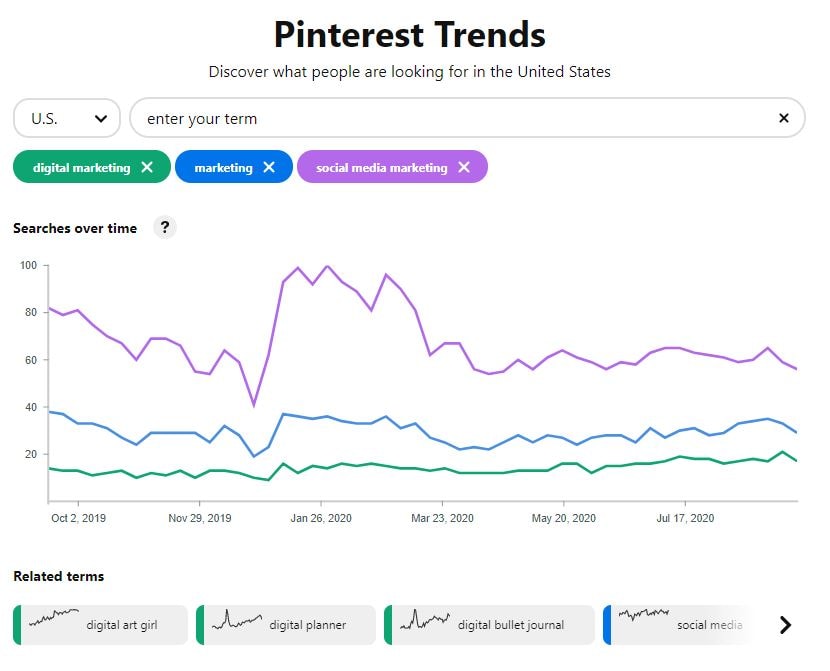
Pinterest is a visual platform that helps me discover trending and evergreen product ideas. It’s perfect for finding products in niches like home decor, fashion, and DIY.
Main Features:
- Search by Categories: Explore ideas in specific niches like “unique gift ideas” or “trending fashion.”
- Pinterest Trends Tool: Tracks what’s popular in different categories over time.
- Save Pins to Boards: Organize ideas for later validation and research.
How to Find Winning Products on Pinterest:
- Search for keywords related to your niche, like “home organization” or “travel must-haves.” Look for pins with high saves and engagement.
- Use the Pinterest Trends Tool to identify rising trends and seasonal opportunities.
- Save product ideas to boards and revisit them later to validate demand with tools like Sell The Trend.
Pros:
- Great for visual inspiration and long-term trends.
- Easy to identify products that appeal to specific audiences.
- Free to use and accessible for all sellers.
Cons:
- Doesn’t provide sales or competition data.
- Requires additional tools for validation.
How To Identify Winning Products: 4 FAQs
Here are common questions to help you understand how to identify profitable dropshipping products and build a successful dropshipping business.
1. How Do You Know If It’s A Winning Product?
A winning product solves a problem or fulfills a desire. Look for items with steady demand and growing interest in market trends. Tools like Google Trends, SEMrush, and Amazon Best Sellers can help you identify dropshipping products to sell. For example, products in the pet supplies niche, baby products market are consistently in demand and ideal for building a profitable dropshipping business.
2. How Do You Create A Winning Product?
Creating a winning product starts with understanding your audience. Research what pet owners, parents, or car enthusiasts need and tailor your offering to meet their demands. Combine trends from profitable dropshipping niches with creative branding and unique packaging.
For example, bundling profitable dropshipping products like pet grooming tools or baby care kits can help you stand out in your dropshipping store and boost sales.
3. What Is The Most Successful Dropshipping Item?
The most successful dropshipping products vary, but they all share key traits: they solve problems, are affordable, and have high demand. Popular categories include the pet supplies niche, tech gadgets, baby care items, and automotive accessories in the global car accessories market.
Items like wireless car air compressors, reusable baby wipes, and eco-friendly pet toys consistently rank among best selling dropshipping products.
4. How To Find Winning Products For Shopify?
To find winning products for Shopify, focus on tools and strategies that align with your dropshipping business. Use a platform like Sell The Trend to identify trending items with growing sales and positive reviews.
Testing products through small ad campaigns can also help you identify what resonates with your audience, ensuring you build a successful dropshipping business.
Conclusion
Finding winning products is key to a successful dropshipping business. Focus on items that solve problems, stand out, and have strong demand.
Use tools like Sell The Trend to simplify your research and gain an edge over competitors. Combine data-driven insights with your knowledge of customer needs, and don’t be afraid to test and refine your approach. With the right strategy, your dropshipping business can turn potential into profit.







